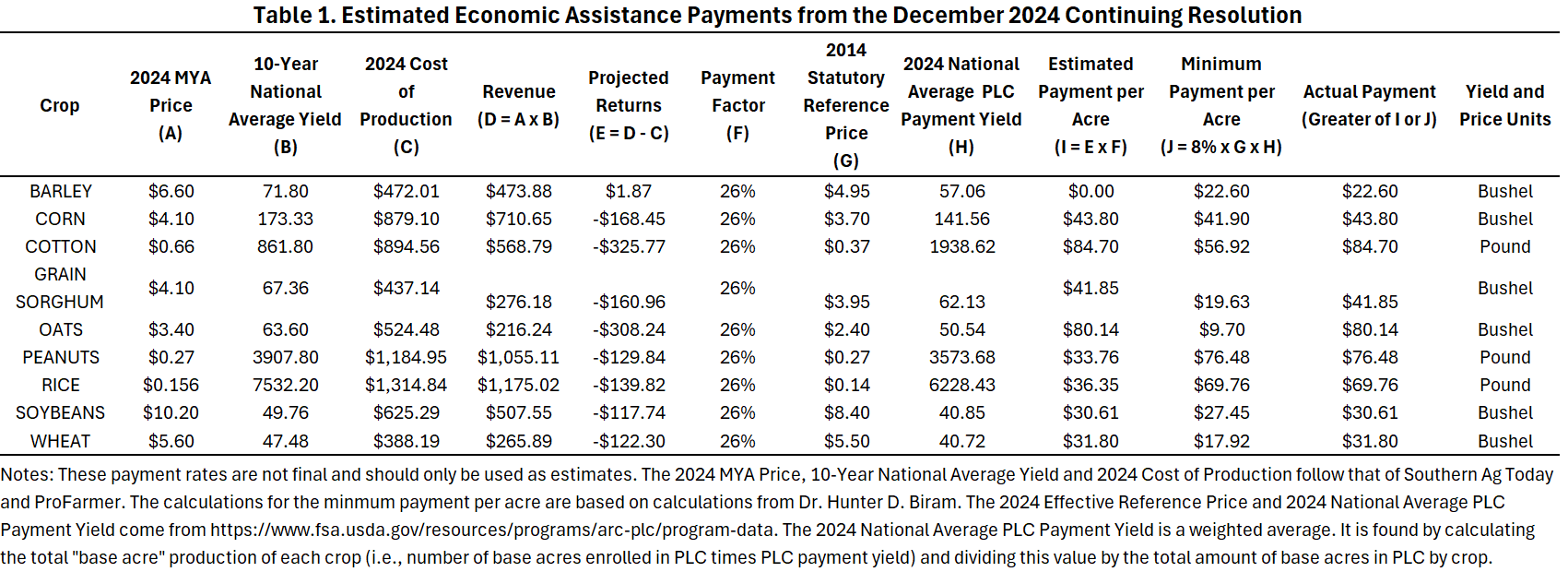Farm aid could be on the way with proposed Continuing Resolution
Dec. 18, 2024
By Sarah Cato
U of A System Division of Agriculture
Fast Facts:
- Continuing Resolution released Tuesday includes $10 billion in farm aid
- Will extend 2018 Farm Bill through September 2025
- Deadline to pass government funding bill is Dec. 20
(322 words)
(NEWSROOMS: download art of payment calculations.)
LITTLE ROCK – Amid worries that an expired Farm Bill would leave farmers without an economic safety net, Congressional leadership released a Continuing Resolution Tuesday that includes $10 billion for crop producers.
This new agricultural aid package follows the payment mechanism laid out by the previously proposed Farmer Revenue Assistance Mitigation Act. Hunter Biram, extension economist for the University of Arkansas System Division of Agriculture said the payments are based on three key variables: National season-average price reported, 10-year national average yield and 2024 cost of production.
“Two key elements of this payment mechanism differ from the FARM Act,” Biram said. “The payment factor has been reduced from 60 percent to 26 percent of the estimated economic loss. However, a minimum payment has been included.”
Biram said the minimum payment will be the product of 8 percent of the statutory reference price laid out in the 2014 and 2018 farm bills and the national Price Loss Coverage payment yield to be determined by USDA.
“Among the nine program crops that are relevant to farmers in the southeast, three should expect to see the minimum payment be greater than the estimated payment,” Biram said. “This includes barley, peanuts and rice. The other six program crops considered will receive the estimated payment per acre. These include corn, cotton, grain sorghum, pats, soybeans and wheat.”
Although the resolution has been the subject of much discussion, Biram said it is important to remember it still has to pass.
“The deadline to pass a funding bill to avoid a government shutdown is Dec. 20,” he said. “While Speaker Mike Johnson (R-LA-04) and Senate Majority Leader John Thune (R-SD) have both voiced support for economic assistance to farmers, there has been opposition from GOP hardliners who have voiced frustrations over not pushing funding issues to 2025.
“Economic assistance seems likely, but we will not know with full certainty until the bill passes. The situation is very fluid,” Biram said.
To learn more about Division of Agriculture research, visit the Arkansas Agricultural Experiment Station website: https://aaes.uada.edu. Follow on Twitter at @ArkAgResearch. To learn more about the Division of Agriculture, visit https://uada.edu/. Follow us on Twitter at @AgInArk. To learn about extension programs in Arkansas, contact your local Cooperative Extension Service agent or visit www.uaex.uada.edu.
About the Division of Agriculture
The University of Arkansas System Division of Agriculture’s mission is to strengthen agriculture, communities, and families by connecting trusted research to the adoption of best practices. Through the Agricultural Experiment Station and the Cooperative Extension Service, the Division of Agriculture conducts research and extension work within the nation’s historic land grant education system.
The Division of Agriculture is one of 20 entities within the University of Arkansas System. It has offices in all 75 counties in Arkansas and faculty on five system campuses.
Pursuant to 7 CFR § 15.3, the University of Arkansas System Division of Agriculture offers all its Extension and Research programs and services (including employment) without regard to race, color, sex, national origin, religion, age, disability, marital or veteran status, genetic information, sexual preference, pregnancy or any other legally protected status, and is an equal opportunity institution.
# # #
Media Contact: Sarah Cato
U of A System Division of Agriculture
Cooperative Extension Service
870-815-9035
